Start with the mount. Just as the scabbard called “Avalon” was more powerful than “Excalibur” (the blade it sheathed), the positioning mechanism (“mount”) is more important than the telescope. In every case here, you could keep the telescope, but throw out the mount. But any telescope is better than no telescope. Given the limitations, if $159 is your price point, then these will show the stars you cannot see.
Meade 70-mm StarPro Refractor
Celestron 70-mm AstroMaster Refractor
National Geographic 70-mm Refractor
Celestron AstroMaster 70 AZ Refractor Focal length=900mm; ratio f/13. $189.95 from Mile High Astro. Comes with two Kellner oculars, 20mm and 10mm.
Meade StarPro AZ 70mm Refractor Focal length=700mm; ratio f/10. $159.99 from Mile High Astro. Comes with three Kellner eyepieces, 26mm, 9mm, and 6.3mm oculars; and a 2X Barlow lens.
National Geographic Refractor Focal length=700; ratio f/10. $109.99 from Explore Scientific. Comes with two Ploessl oculars, 26mm and 9.7mm, and a 2X Barlow lens.
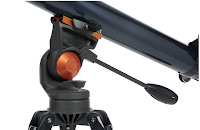 |
| CELESTRON PAN-TILT MOUNT |
The Celestron pan-tilt mount is even worse. It is too tight even after disassembly, degreasing, and relubrication with WD-40 Silicon. In these tests, the Celestron was usually on an Explore Scientific First Light mount. In fact, after fighting with the mounts, the first night, I set them into an Explore Scientific Twilight I mount for its ease and stability.
The mount and tripod of the National Geographic is a bad design. The altitude (or declination) is a twist knob screw drive and that works well. However, the thumbwheel for the right-left (azimuth or right ascension) was immovable with my left thumb, and jerky with my right.
Overall, the Meade is the best of three. I was disappointed in the Celestron because I had hoped to make good use of its longer 900 mm focal length. However, it did not stand up to simple backyard stargazing. The National Geographic was worst of the three. The objective lens was flawed, displaying ghost images from internal reflection. I already own a National Geographic that I was happy with and I bought this to test against it. The new one is not as good as the old one. The old one does not have ghosts.
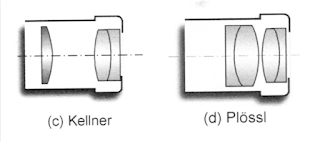 |
| From Star Ware by Philip S. Harrington |
Overall, these do their best work with stars, not planets. With all three, among the first views were the Orion Nebula (Messier 42), resolving the interior Trapezium group, and then turning to the nearby open cluster Messier 41 (below Sirius). The last sessions were simple tours of the rich star field near Delta Cygni, the center of the Swan or Northern Cross. It was enjoyable because the area offers so many stars including red giants and binary stars.
Jupiter, Saturn, and Venus were all challenging and disappointing in all three telescopes. I could identify the planets. The rings of Saturn were easy to define. However, all were plagued by cloudy, foggy glare from the bright disks.
However, the Meade had a saving grace. It comes with an aperture reducer, a clever old hack from experienced observers, a mask--in this case a hole in the dust cover--which allows a limited cone of light increasing the focal ratio by reducing the aperture in order to bring out more details in planets, but at a cost of brightness.
After trying out all three in their "native mode" with the eyepieces provided in the package, I followed the advice offered by a customer service representative from Mile High Astro and tried them with my best oculars.
06 November 2021 Testing with the best oculars:
TeleVue Nagler-1 82-degree 7mm
Meade 82-degree 14mm
Vixen SLV 25mm.
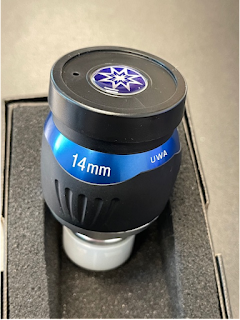 |
| (discount priced) Meade logo but no name Series 5000 14 mm 82-degree field of view |
1915 hours
Meade 70-mm StarPro with 7-mm. Nagler
Saturn. 1 band north. 1 ring. Some hint of texture to the ring on the east side.
Titan? and Tethys? (It seemed so at the time, but the Sky & Telescope “Saturn” page (here) says no: these were just stars in the field.)
Jupiter. Hard to focus. Some chromatic aberration but north and south bands visible and some texture to equatorial region.
1938 hours
Celestron 70-mm AstroMaster with 7-mm Nagler.
Saturn. Hazy. Foggy. Titan (or star) discernable. Ring visible. 1 band north. Near limit of resolution. Image spotty and grainy.
1947 hours
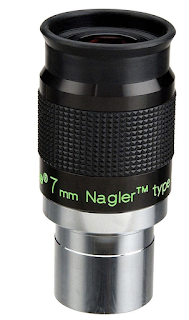 |
Nagler 7mm Type 1 82-degree Field of View 12mm Eye Relief 7 element system |
Jupiter. Hazy. Foggy. Near limit of resolution? (Inspected objective lens and diagonal prism for dew or condensation, but both were clear.)
1955 hours
Celestron 70-mm AstroMaster with 14-mm Meade.
Jupiter smaller (of course). Not as foggy. Still hints of diffraction rings. Two bands discernable.
(Checked magnification: 900 / 14 = 64+. It should be a clear view.)
2005 hours
Meade 70-mm StarPro with Meade 82-degree 14mm. (50X)
Jupiter. Nice view. 2 bands. Some chromatic aberration. Not bad.
Used aperture reducer. Sharper image. More detail on planet. Not as bright. But more detail in the equatorial between the bands North and South.
2016
Meade 70-mm StarPro with Meade 82-degree 14mm. (50X)
Saturn with aperture reducer.
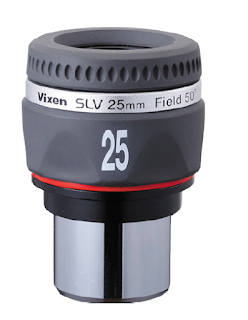 |
| Vixen SLV Lanthanum coated Twist-up eye cup All metal body |
2032
Meade 70-mm StarPro with Vixen SLV 25-mm
Delta Cygni region.
Lots of stars. Focus OK, not perfect, but close. Scanning area, settled on a red star at center and a discernable binary to the north or east. Lots of stars to look at in my Bortle 7-8 with no Milky Way. The telescope comes with a Modified Achromatic (Kellner) 26-mm, which is OK.
07 November 2036
Celestron 70-mm AstroMaster with Vixen SLV 25-mm Delta Cygni region. (see above: The area is rich with targets to observe, record, and enjoy. This telescope comes with two eyepieces, 10mm and 20mm, which magnify too much (45X and 90X) for broad and wide fields such as this, the Pleiades, and the Moon.
Because the project began with the challenge to split the double-double of epsilon Lyrae with a 70-mm refractor, here are those notes.
01 November 2021
Celestron AstroMaster 70-mm refractor.
1948 Installed Celestron Lens&Filter kit Ploessl 6mm and kit 2X Barlow and successfully split the companions E Lyrae E1A and E Lyrae E2A.
 |
| Smaller, of course, but about like this |
05 November 2021
1955 Chasing epsilon Lyrae.
2011 Chasing epsilon Lyrae.
Celestron 70-mm AstroMaster with 8mm Celestron Ploessl and 2X Barlow.
Note that northern members are touching. Western pair definitely separated. I tried the 6mm with 2X Barlow but it was just too hard to fight with the pan-tilt camera mount.
PREVIOUSLY ON NECESSARY FACTS
Product Review Celestron AVX Mount and Tripod
Galileo and Saturn: Epistemology, not Optics
Observing with NASA: An Open Platform for Citizen Science
Below the fold.
Open the Jump to see all of the notes that I took 31 October to 05 November 2021.
70-Millimeter Shootout
First night
30-31 October 2021
Keep the telescopes. Throw away the mounts.
The right ascension gear does not work at all on the Meade. No matter how much I turn the handle, the telescope does not move.
The action on the Celestron pan-tilt handle is so tight that it lifts the tripod and telescope off the ground without moving the telescope up-down or -left-right.
So, I mounted each in turn to an Explore Scientific Twilight, which I use for my Explore 102-mm refractor. From there, I tested the optics. Both were all right for what they were. My original intention was to test these and then give them away. Now I want to keep them both. In truth, I will not keep these though they are temping as “grab-and-go” instruments.
31 October
02:00 hours Central US Time.
Celestron 20mm and 10mm oculars: Orion Nebula is OK in each. Trapezium is easy to distinguish.
20mm on Sigma Orionis group. 20 mm shows the close companion to sigma Ori. 10mm shows it better at the Airy limit.
02:25 Found eta Cassiopeiai with 10mm. At the Airy limit.
02:45 Meade 25mm on the Pleiades, very nice.
02:48 25 mm. Orion nebula easy focus, wide view. Trapezium easy. Sigma Orionis good. Shows companion.
02:53 9mm. M42. Trapezium. Better contrast to the cloud than in the Celestron, perhaps because it is now higher in the sky.
02:57 9 mm on Sigma Orionis.
03:02 6.3 mm on sigma Ori shows the double red pair. (This was impressive. I recorded this group earlier in the year but I saw the faint red paid for the first time on 29 October using my ES 102-mm.)
03:05 26 mm on M 41 open cluster.
03:10 Celestron with 20mm on M41.
03:18 Celestron 20 mm on eta Cassiopeiai. 10 mm shows better with Airy disc.
0340 – Dew point. Brought everything in.
01 November 2021
0009 Hours.
Jupiter. Explore Scientific 25-mm “Super Plössl” View is better but still bad.
The Meade StarPro comes with a range of oculars - 26 mm, 12 mm, and 6.3 mm, and a 2X Barlow lens.
1940 hours. Finding e Lyrae easily with the 26mm, I stepped all the way down to the 6.3mm with 2X Barlow for an effective magnification of 222 before the view was acceptable though not unequivocal. At that magnification, it was dim, yellowish, and granular, past the threshold for good resolution. I noted that I could identify each star and its companion only because I knew what to expect. The pair on the right (corrected view) was separated but not on the left, only a bulge of light on the star disc.
1945 hours. Switched to Nagler 7mm with 2X Barlow from my Celestron Lens & Filter kit. No joy.
Celestron Astromaster 70-mm comes with a 10mm and a 20mm ocular and I did not bother with those time around having been there and done that with these when they first arrived.
1948 Installed Celestron Lens&Fliter kit Ploessl 6mm and kit 2X Barlow and successfully split the companions E Lyrae E1A and E Lyrae E2A.
Monday, 01 November 2021
National Geographic 70-mm Refractor (new) from Explore Scientific.
Comes with Bresser 26mm and 9.7mm Ploessl oculars and Bresser 2X Barlow.
1908 hours: Set up and aligned finder with Venus. Added Celestron neutral density filter (NDF “Moon filter”) to cut the glare of the planet and see phase. Also note that this is not a correcting diagonal, just a mirror. West was to the right and the bright side of Venus was to left (east).
Mount action is tight. It is easier to move the telescope by hand. Altitude (declination) control twist works better than the azimuth (right ascension) thumbwheel which is too tight.
26-mm Bresser Ploessl. Venus.
9-mm Bresser Ploessl. Chromatic aberration is pronounced, top to bottom of Venus blue-yellow-red. Difficult to focus.
1947 hours: epsilon Lyrae. 9.7 – I can almost see the companions.
1950 hours: epsilon Lyrae. tried 8mm Celestron Ploessl. Closer, no cigar.
1953 hours: epsilon Lyrae. Tried 9.7 Bresser with Bresser Barlow. Past the resolution limit. Just blobs of color.
2002 hours: epsilon Lyrae. Tried Nagler 7mm – more promise. Tantalizing but no, not yet.
2009 hours: epsilon Lyrae. Tried Celestron 14 mm – and can almost see the companions when the telescope shakes. This is a phenomenon I have read about: wiggling the telescope reveals details because the eye responds to motion.
2012 hours: epsilon Lyrae. Tried Celestron 8mm with Celestron 2X Barlow. Colored blobs. No joy.
2021 hours: Eta Cassiopeiai. 9.7mm Bresser with 2X Bresser Barlow. Identifiable only because I know what I was looking at. The image is a colored blob (vertical: blue-yellow-red) with another white dot to the right.
2029 hours: Saturn. Bresser 26 mm. Ring is discernable.
2033 hours: Saturn. Bresser 9.7 mm. Better gap between ring and planet. But planet has blue-yellow-red vertical chromatic aberration and a ghost image above.
2039 hours: Saturn. My old National Geographic with Bresser 26-mm. Saturn is clean and sharp. Yellow. The ring is crisp. Titan is a likely dot.
2045 hours: Saturn. New Natl G: With Explore 26-mm Super Plössl. No help.
2045 hours: Saturn. Old Natl G: With Explore 26-mm Super Plössl. No problem.
Side by Side: My old Natl G with the new Natl G. Both with Explore 26-mm Super Plössl.
Target: Albireo. Old stars are more round. New stars are more sparkly.
2305 hours: Jupiter. New National G with SvBony 40mm
2320 hours: Jupiter is not round. New and Old show the same problem, but the Old is not as pronounced.
2325 hours: Jupiter in the Old Natl G is round. So, was the problem the atmosphere?
Cloudy now for a few days.
Next tests on all three (new) 70-mm entry level refractors will be on the waxing crescent Moon this weekend Friday to Sunday 5-7 November.
05 November 2021
Celestron 70 mm Astromaster
Meade 70 mm StarPro
Testing both with better oculars.
1850 hours: Venus
Celestron with 25mm Super Ploessl and two filters to cut glare of planet.
Moon filter (NDF) and Red 25
NDF and Deep Yellow 12
Both pairs work well. Nice views. Some aberration, glare mostly, not rainbows. Focus not always perfect. However, dark side of Venus is apparent.
Tried prescription (astigmatic correcting) reading glasses. Some help. Sharper focus. Some glare, aberration.
1900 hours
Meade with 25 mm Super Ploessl. NDF and Deep Yellow 12. Venus not OK. No dark half. Some image aberration. Focus difficult. Prescription (astigmatic correcting)reading glasses some help for sharper focus. Still some aberration: glare not rainbow.
1916 tried with Red 25 and Orange 21 and then with Red 12 and Blue 80A. No differences. Just makes the planet easier to see.
1918 Meade with 25 mm Super Ploessl and NDF.
Just makes it hard to see. Everything is dim. Less detail on planet.
1926: NDF and Deep Yellow 12. NDF and Red. Not any different. No help.
1926 Jupiter. No filters.
Some markings visible along the equator north and south. Broad central band.
8 mm Celestron Ploessl.
Nice view. Some detail. Broad central band.
1936 Celestron with 25 mm Super Ploessl.
Jupiter. Nice view. Not much detail.
1938 8mm Celestron Ploessl. More detail and more aberration, not rainbow almost like Airy disks with glare rings around the image.
1955 Chasing epsilon Lyrae.
Meade 70-mm StarPro with Celestron Ploessl 6mm and 2X Barlow
Success.
Searching for zeta Lyrae and delta Lyrae. No joy. Either I could not find them or they are not apparent in this arrangement.
2011 Chasing epsilon Lyrae.
Celestron 70-mm AstroMaster with 8mm Celestron Ploessl and 2X Barlow.
Note that northern members are touching. Western pair definitely separated.
Tried 6mm with Barlow but it was just too hard to fight with the pan-tilt camera mount. (See other notes. I called Mile High Astro and chatted with Zach over this when the scope first arrived. On his suggestion, I took it apart, loosened the fittings, cleaned off the Chinese grease, and lubricated the bearing. But it was not enough. It needs more better proper engagement.)
2025 hours
Saturn
Meade StarPro with Celestron 9mm Ploessl. OK.
2015 hours
Albireo
(Put the Celestron on the Meade mount for better working.)
Used Celestron native 20mm and 10mm Kellner eyepieces.
View acceptable.
2110 epsilon Lyrae again
Celestron AstroMaster
Nagler 7mm with Celestron 2X Barlow.
Both stars are just colored blobs. No help.
Getting dewy. Packed up and took everything inside.


No comments:
Post a Comment
Note: Only a member of this blog may post a comment.